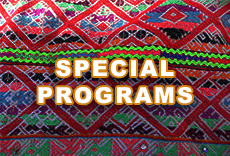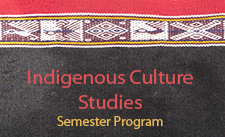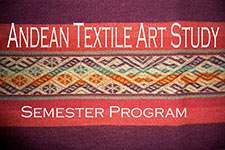PRE-COLUMBIAN ART, DESIGN AND ARCHITECTURE

The pre-Hispanic civilizations developed their arts, designs, textile garments, goldsmith work and ceramics, architecture, urban planning and landscape architecture, under the concept of the visualization of the Cosmos´ principles and Nature´s laws. These designs´ fundamental parameters are based on centricity, symmetry, duality and complementary relationships. In our programs, participants are introduced to the Andean cosmo-vision, observation of nature and astronomy, as well as to their application in design.
Practical areas: Textile painting, dyeing with pre-Columbian techniques, painting on ceramics and murals, as well as the application of designs and architectural models will allow the interiorizing of the course´s set of topics.
The below described courses are also available online via Skype or Zoom. For more information, contact us here:
The courses´ sets of topics:
Pacha Qhawarichiy: Visualize Time and Space
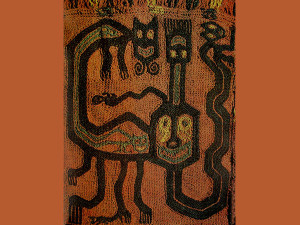 Nature, reality and the magical and religious world; everything is moving, changing and recreates itself in each instant. Not only did the Paracas artists “thematize” the physical appearance of a human, vegetable or divine being, but they also manifested it in its totality, with its full potential in which creation, fertility and development are fundamental. They wove and embroidered robes that were ritual shrouds for the mummified. The shape and content unite with the strength of a visual metaphor, and are repeated with other components, creating a dynamic conceptual rhythm. Nature, reality and the magical and religious world; everything is moving, changing and recreates itself in each instant. Not only did the Paracas artists “thematize” the physical appearance of a human, vegetable or divine being, but they also manifested it in its totality, with its full potential in which creation, fertility and development are fundamental. They wove and embroidered robes that were ritual shrouds for the mummified. The shape and content unite with the strength of a visual metaphor, and are repeated with other components, creating a dynamic conceptual rhythm.
We´ll examine the language, symbolism and iconography of the invisible world and how to make visible what cannot be seen. Part of the learning process is the transmission of agricultural and astronomical knowledge through ritual calendars, represented in textiles, ceramics, sculptures and goldsmith work. This way, we´ll discover the patterns and schemes pre-Columbians developed in their designs, to visualize the order of time and space. |
Intiq Pachan: The Sun´s Time and Space
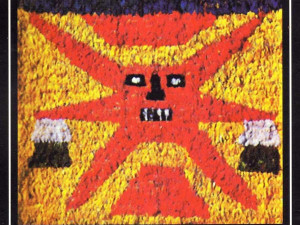 In the Andean cosmology, the Sun is masculine and is venerated as Father (Tayta Inti). We´ll see the function of the non-human entities´ anthropomorphism, and the Sun´s biological influence on Earth. Likewise from the astronomical perspective, we´ll examine the logics of the Sun´s rectangular shape and of its four corners, which is an icon frequently represented in Andean textile art and ceramics. Therefore, we´ll understand the logics of solar time and space quatri-partition and its application in the agricultural calendar. Finally all of this will guide us to pre-Columbian garments and fabrics, and we´ll see its solar application in textiles and goldsmith work, as well as in what refers to today´s textiles. In the Andean cosmology, the Sun is masculine and is venerated as Father (Tayta Inti). We´ll see the function of the non-human entities´ anthropomorphism, and the Sun´s biological influence on Earth. Likewise from the astronomical perspective, we´ll examine the logics of the Sun´s rectangular shape and of its four corners, which is an icon frequently represented in Andean textile art and ceramics. Therefore, we´ll understand the logics of solar time and space quatri-partition and its application in the agricultural calendar. Finally all of this will guide us to pre-Columbian garments and fabrics, and we´ll see its solar application in textiles and goldsmith work, as well as in what refers to today´s textiles.
|
Killaq Pachan: The Moon´s Time and Space
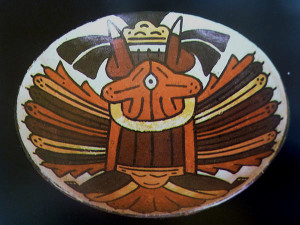
Since the Moon is considered as feminine in Andean cosmology, it is closely related to feminine cycles. The Moon lacks defined shape, and its cycle is more complex than that of the Sun. Participants will learn about lunar phases and their cyclical movements, comparing their representation in pre-Columbian textiles and ceramics. While visualizing through drawings and paintings the moon cycles, we will experience similar or equal pre-Columbian designs. |
Puriq Ch’askakunaq Pachanku: The Planets´ Time and Space
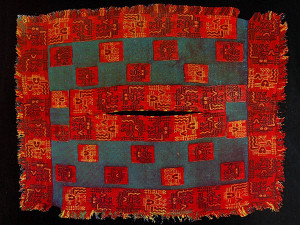
This course is focused on the planets´ astronomical cycles, and on how their different cycles produce conjunctions, oppositions and alignments, while giving them a celestial rhythm with different pulses. Therefore, we´ll see that in the Paracas Civilization´s textiles, the same numerology is visualized as in the Mayan Calendar. With that key, we´ll discover in their textiles, how these teach us the numbers of the days and those of the planets´ sidereal and synodic years, but also the great art of turning more complex time periods and cycles into zoomorphic and anthropomorphic shapes, while giving visible appearances to what the human eye cannot see, but which is a great astronomical knowledge the human being can learn and put into application. |
Masculine and Feminine Power in the Andean Cosmo-vision and Society
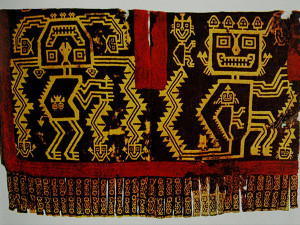 The agricultural and astronomical scheme is the basis and logics of pre-Hispanic civilizations´ social and political structures, and it is still alive up to this day in traditional indigenous communities. Since ancestral time, these concepts are set and transmitted, as much in textile art, as in goldsmith work and ceramics. The agricultural and astronomical scheme is the basis and logics of pre-Hispanic civilizations´ social and political structures, and it is still alive up to this day in traditional indigenous communities. Since ancestral time, these concepts are set and transmitted, as much in textile art, as in goldsmith work and ceramics.
The Quechua language allows us to speak without defining genders, in such a way that the definition of masculine, feminine and androgynous, along with all ranges within genders, requires deep reflection on the role and function of each individual being and entity in the Cosmos.
We´ll approach the concepts of duality and quatri-partition, as main patterns of the pre-Incas´ and Incas´ territorial and political structures, and will see how this concept was applied in feminine and masculine power in pre-Hispanic societies. We´ll examine the diarchy´s version in the Incan State, and the Inca´s and Qoya´s roles in social, political and religious spaces. We´ll see how the textiles, garments and goldsmith work not only convey a sense of status, but also surround the human body with a whole symbolic and stylized cosmos. |
Duality and Tinku
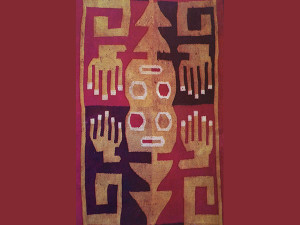
The Tinku is the encounter of the opposed complements; a liminal point or line, from which the forces of creation, and those of destruction have their origin. There are natural and ritual Tinkus. We´ll explore the Tinkus, in the Cosmos and Nature, as well as the rites and performances represented, as much in pre-Columbian art, for example in Mochica ceramics in particular, and in the pre-Hispanic woven fabrics in general, and also in rites, dances and ritual battles performed in today´s Andean culture. |
Death and Fertility in the Andean Cosmo-vision
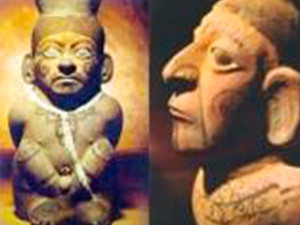 The issue on human sacrifices is as repugnant, as it is fascinating. Above all, focusing from an occidental cosmo-vision, it is almost impossible to understand such rituals. However, pre-Columbian art shows us how to see the world in a different way, and opens a very different vision to us about death. Part of our thematic will also focus on today´s ritual ‘battles’, and we´ll explore the logic of offerings and the sacrifices that are part of the mask dancers´ performance during patronal celebrations and pilgrimages. The issue on human sacrifices is as repugnant, as it is fascinating. Above all, focusing from an occidental cosmo-vision, it is almost impossible to understand such rituals. However, pre-Columbian art shows us how to see the world in a different way, and opens a very different vision to us about death. Part of our thematic will also focus on today´s ritual ‘battles’, and we´ll explore the logic of offerings and the sacrifices that are part of the mask dancers´ performance during patronal celebrations and pilgrimages.
|
Puma Runa, a Journey through Time and Space
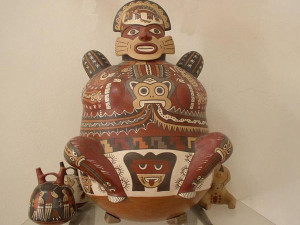 The Pumaruna (Puma man) is a central figure in pre-Columbian art, and we find him in all of Peru´s ancient cultures. So, we´ll follow his tracks, to discover the great diversity of his manifestations, navigating through different cultures and time periods. It is a fascinating travel, that guides us from ancestral time and space, to present days, as we discover millenary patterns applied in textile and sculptural designs that still keep on pulsating in the Andean textile art. The Pumaruna (Puma man) is a central figure in pre-Columbian art, and we find him in all of Peru´s ancient cultures. So, we´ll follow his tracks, to discover the great diversity of his manifestations, navigating through different cultures and time periods. It is a fascinating travel, that guides us from ancestral time and space, to present days, as we discover millenary patterns applied in textile and sculptural designs that still keep on pulsating in the Andean textile art.
|
Incan Architecture and Archaeo-Astronomy: Time in Space
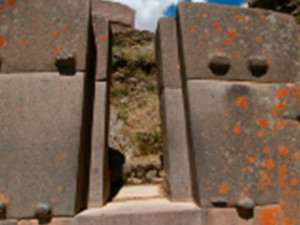 Archeo-astronomy teaches us the alignments of temples and roads with celestial bodies. Once again, we´ll focus from solar space which is integrated as a constant parameter in Incan architecture, with its windows and niches oriented towards solstices and equinoxes, landscape architecture and the landscape´s calendar with the ‘sucancas’ or astronomical pillars. We´ll also focus our attention on the tools and techniques pre-Incan and Incan astronomers used to observe solar and stellar movements with precision. Archeo-astronomy teaches us the alignments of temples and roads with celestial bodies. Once again, we´ll focus from solar space which is integrated as a constant parameter in Incan architecture, with its windows and niches oriented towards solstices and equinoxes, landscape architecture and the landscape´s calendar with the ‘sucancas’ or astronomical pillars. We´ll also focus our attention on the tools and techniques pre-Incan and Incan astronomers used to observe solar and stellar movements with precision.
We´ll make architectural models, as we´ll verify Time´s integration into Space with illuminations that simulate the Sunrays´ trajectory on the most significant dates. We´ll observe as much the illuminations, as the projected shadows, that are the two opposites generated and projected by the sundial.
As an extension, we´ll see the representation of the temples and architectural patterns in pre-Colombian ceramics and textiles. It is very interesting to see how the pre-Hispanics manifested the third dimension, along with temporality, in two-dimensional textiles. |
-
-
-
For questions or more information just write us.
|














